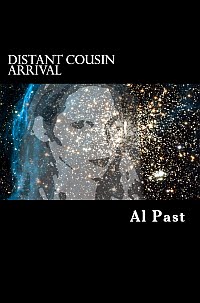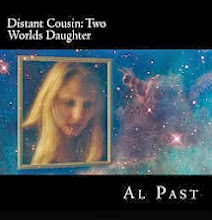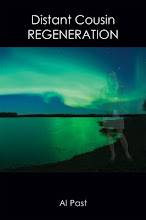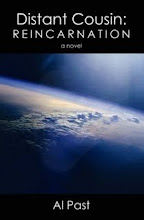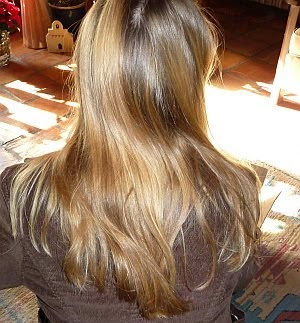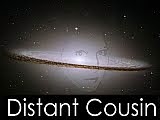
(The graphic above (with thanks to
Bucknell University) is discussed below. If you right click it and open it in another tab, it will be conveniently available.)
The language of Ana's people on their home planet, Thomo, was touched on briefly in
Distant Cousin, chapter 20, when Ana first met Dr.William Sledd, a philologist and linguist. Perhaps this is the place to delve a bit more into the history of her language and her people. We'll get to what clues from her language electrified Dr. Sledd below.
As you may have read in her
responses to reader questions (Question 4), Ana's ancestors had been transplanted to Thomo some 162 generations ago. Using the standard Earth figure for one generation, 20 years (the typical time for an infant to grow to adulthood and have children), we can calculate that her people were removed from Earth approximately 3260 years before the present era, give or take. We also learn, in DC3,
Distant Cousin: Reincarnation, that she seems to have some mysterious ties to the people of the Caucasus, near the Black Sea, on the dividing line between Europe and Asia.
That region is thought to have been the homeland of the Proto-Indo-European tribes from which today's Indo-European languages sprang. Three thousand years is a long time, and the nomadic peoples who lived in that area left
almost nothing of themselves behind. The detective work which points to them as the original speakers of Indo-European has been almost entirely linguistic in nature, based on examination of similarities and differences between their modern descendant languages. (This was touched on in
Distant Cousin, Book 2, chapter 18.) Volumes have been written about this scholarly detective work, but the details are far beyond what can be covered here.
Suffice it to say that over many centuries, tribes of nomadic Indo-Europeans wandered far from home, never to return. Some went as far as present-day India. Others stopped in Iran and Afganistan. Still others went to Scandanavia, and throughout Europe. As they settled and multiplied in their new areas, their language changed over time, to fit their local conditions. In brief, the result is today's collection of modern Indo-European languages, which when graphed resembles a family tree, complete with multiple branches.
The branches of this "family tree" mostly correspond to the geographical areas of the globe that the ancient wanderers settled. (See the graphic.) There is an Indian branch, for example, a Hellenic branch, an Italic branch, and Iranian, Germanic, and Balto-Slavic branches. Each one of these branches has split into numerous other languages over time.
To mention just one example, take the Italic branch. Two thousand years ago, the language of the Indo-Europeans who had settled in the Italian peninsula had slowly become Latin. Likewise, the Hellenic group was speaking classical Greek. The ancient Indo-European language in India evolved to Sanskrit, still studied today much as Latin and Greek are in the West.
Again, that was two thousand years ago, a long time. The Roman Empire spread Latin throughout Europe until it collapsed about the year 400, leaving Latin speakers largely scattered and isolated (the so-called "Dark Ages," not really all that dark). Over the following centuries their Latin changed slowly in all the places they remained, eventually becoming mutually unintelligible, in effect, different languages: French, Spanish, Italian, Portuguese, Catalan, and so forth.
Similar things happened with the Germanic branch (which evolved to German, Dutch, English, Danish, etc.), with Sanskrit (Hindi, Bengali, Kashmiri, Gujarati, etc.), and with other branches. (Refer to the graphic for a few more examples. Also note that most college desk dictionaries contain a chart of these, usually under "Indo-European Languages.") A little study of the chart will provide several insights. The parent language of modern English is Germanic. The parent language of modern Spanish is Latin. Going further back one linguistic "generation," the parent of Germanic and Latin is Proto-Indo-European. In a human family tree, what do you call two indviduals who have different parents but the same grandparents? Cousins, of course. Keeping in mind that this is only a memory aide and not a statement of actual relations, one could loosely say that English and Spanish are cousin languages, as are English and Italian, English and Hindi, Russian and Swedish, English and Farsi (spoken in Iran) and so forth.
Now we are ready to go back to Dr. Sledd in his study in Alpine, Texas. Matt Mendez told him Ana's station manager was named "Hleo." Sledd showed Matt a dictionary of Ango-Saxon, the language of Beowulf: "hleo" is the Old English word for "shelter," "protector," which suggested to him that her language fell under the Germanic group. Then, later, when Sledd finally met Ana, he learned her last name was "Darshiell," which she said meant "from the rainbow." A modern language with a similar word is French: "d'arciel," also meaning "from the rainbow." This was what astounded him: French comes under the Italic branch, entirely different from the Germanic. Based on only these two words, he had a piece of evidence that her language was related to TWO major branches of the Indo-European family tree--Germanic and Italic. This suggested to him that her language dated from before the time those two groups split apart--which would be very early indeed.
Note that the graphic shows two branches which have no descendants: Albanian and Armenian. Dr. Sledd and his linguistic collaborators have posited, in the monograph they published after working with Ana for a while, that Luvit is another such branch!
The name her people gave their planet, for example, is "Thomo." In Luvit, that "th" has a soft sound, rather like a "d," almost like "domo." It's an obvious cognate with English "domicile," and "domestic." The root word is found in Latin (because Engish borrowed it from Latin, along with thousands of other words, after the Renaissance). It means "home." Thus Luvit has affinities to the Latin branch. But readers who are familiar with the Slavic languages--Czech, Polish, Russian--may recognize some of the other Luvit phrases Ana uses from time to time, which reveal ties to the Slavic branch. Ana's language will never be a major feature of her stories, but anyone who wishes to pursue the matter might start with the
Wikepedia article on the roots of Proto-Indo-European.










